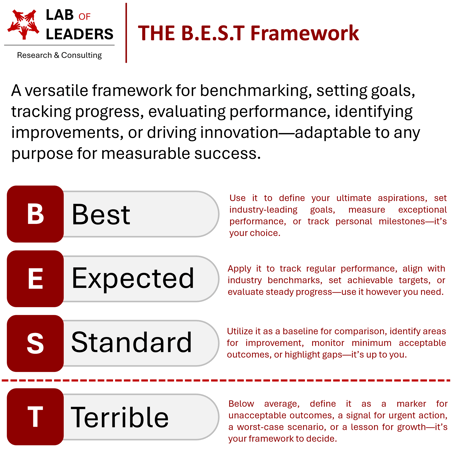The B.E.S.T Framework: Redefining Performance Metrics for Long-Term Success
In the fast-paced world of business, where strategies evolve and industries shift, finding a universal tool to measure and sustain excellence is rare. Yet, during his extensive research on companies with over a century of success, Abdullah Mohammad Abdul Qayyum (MAQ) discovered a profound yet simple way to assess and drive sustainable performance—The B.E.S.T Framework. This innovative framework was unveiled during MAQ’s preparation for Universiti Putra Malaysia’s Global Conference of Business and Economic Research (GCBER) 2024. Its purpose? To provide organizations, teams, and individuals with a flexible, practical, and actionable model to benchmark performance, set goals, and inspire continuous improvement. Here’s how this framework is reshaping the way we think about success.
Abdullah MAQ
12/21/20243 min read


What is The B.E.S.T Framework?
The B.E.S.T Framework categorizes performance into four distinct levels:
Best
Expected
Standard
Terrible
At its core, the framework is a versatile tool that adapts to your needs, whether you’re comparing your organization’s performance to industry leaders, setting personal milestones, or defining internal operational benchmarks. It simplifies the complexity of measuring success by creating clear, actionable categories.
Why The B.E.S.T Framework Works
Unlike rigid models, The B.E.S.T Framework thrives on its adaptability. Here’s why it stands out:
Simplicity Meets Depth: While easy to understand, each level opens avenues for deeper analysis and strategy refinement.
Universality: Applicable across industries, roles, and objectives, from corporate benchmarks to personal goals.
Action-Oriented: Encourages immediate action by clearly defining what success and failure look like.
Sustainability-Focused: Inspired by the strategies of long-lasting companies, it prioritizes growth, humility, and resilience over short-term wins.
Breaking Down the Framework
1. Best:
At this level, you’re operating at peak performance.
What it means: Aspirations achieved, innovation at its finest, and benchmarks set for others to follow.
How to use it: Define what “Best” looks like for you. Is it exceeding industry standards? Achieving personal mastery? Leading the market?
Examples:
A product launch that not only meets sales goals but sets a new industry trend.
A team project celebrated as a benchmark case study.
2. Expected:
This level reflects reliable and consistent performance.
What it means: Meeting objectives, maintaining steady results, and aligning with predefined goals.
How to use it: Compare it to your internal standards, contractual obligations, or client expectations.
Examples:
Delivering a project on time and on budget without surprises.
Meeting quarterly revenue targets consistently.
3. Standard:
The baseline for acceptable performance.
What it means: Meeting the minimum requirements but falling short of excellence.
How to use it: Highlight areas needing improvement or serve as a warning signal.
Examples:
A team’s performance that meets deadlines but lacks creativity.
A product that functions as promised but lacks differentiation.
4. Terrible:
The lowest point—a wake-up call for change.
What it means: Significant underperformance that poses risks to reputation, morale, or business viability.
How to use it: Treat it as an opportunity to analyze gaps, implement corrective actions, and rebuild.
Examples:
A project that fails to deliver on key objectives, leading to client dissatisfaction.
A leadership failure that sparks team disengagement.
Practical Applications
The true power of The B.E.S.T Framework lies in how you use it. Here are some ways organizations and individuals can leverage it:
Organizational Benchmarking: Compare your company’s performance against industry leaders or peers to identify strengths and weaknesses.
Personal Goal-Setting: Use the framework to define what “Best,” “Expected,” and “Standard” mean for your career progression or skill mastery.
Team Evaluations: Provide clarity on what high performance looks like and encourage team members to strive for “Best.”
Crisis Management: Use the “Terrible” category as a tool for honest reflection, helping to diagnose and resolve critical failures.
Innovation Planning: Aim for the “Best” category to foster a culture of creativity and breakthrough thinking.
Why We Developed The B.E.S.T Framework
During his research for Global Conference of Business and Economic Research (GCBER) 2024, Abdullah Mohammad Abdul Qayyum tried to analyze companies that thrived for over 100 years, surviving global crises, market disruptions, and internal challenges for his conference presentation. He noticed great companies consistently assessed and realigned their performance and were very disciplined. The B.E.S.T Framework distills these observations into a practical tool anyone can use, regardless of their industry or goals.
How You Can Start Using The B.E.S.T Framework Today
To begin, ask yourself these key questions:
Define Your Metrics: What does “Best,” “Expected,” “Standard,” and “Terrible” look like in your context?
Set Clear Goals: Where do you want to land, and how will you get there?
Monitor and Adjust: Regularly review your performance levels and make adjustments to stay on track.
By integrating The B.E.S.T Framework into your personal or professional practices, you’ll gain clarity, focus, and a roadmap to sustainable success.
Closing Thoughts
The B.E.S.T Framework is more than just a tool—it’s a mindset. It challenges you to define success on your own terms while learning from the principles of enduring organizations. Developed with a focus on practicality and adaptability, this framework serves as a guide for anyone looking to benchmark, evaluate, and elevate their performance.
Whether you’re an entrepreneur, team leader, or individual contributor, The B.E.S.T Framework empowers you to take charge of your journey, ensuring every effort contributes to long-term, meaningful success.
LAB OF LEADERS
Finding What Works, Simplified For Leaders
Contact Us
+601125101301
© 2024. All rights reserved.
